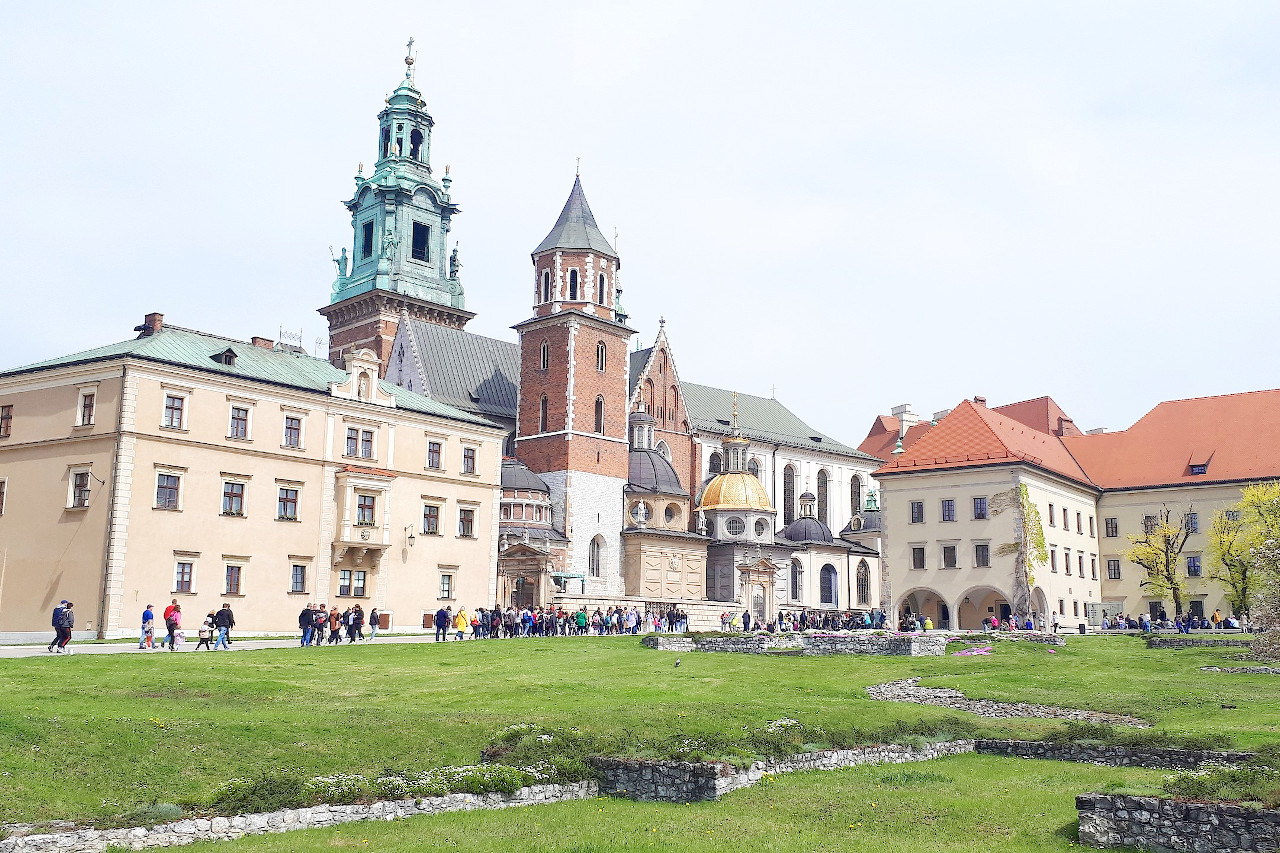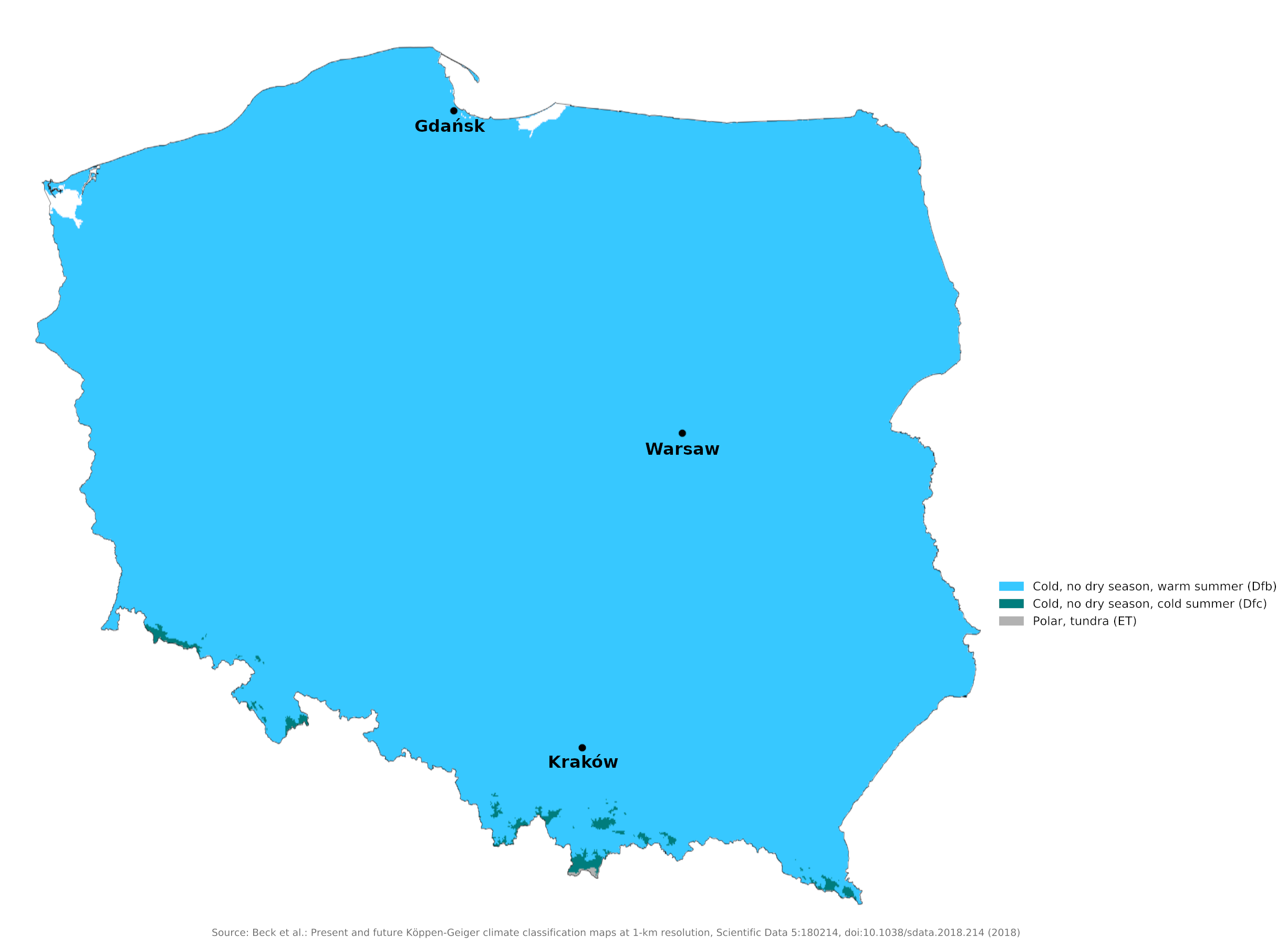The Climate of
Poland
 Wawel Castle, Kraków
Wawel Castle, Kraków
Climate Map
 Climate map of Poland
Climate map of Poland
What is the climate of Poland like?
Poland is located in Eastern Europe and stretches from the coast of the Baltic Sea to the Carpathian Mountains. It is bordered on the north and east by Russia, Lithuania, Belarus, and Ukraine, on the south by Slovakia and the Czech Republic, and on the west by Germany. Most of the country consists of a low-lying hilly plain below 300 meters (1,000 feet) but to the south it includes part of the Sudeten Mountains to the west and the higher Carpathians rising over 1,800 meters (6,000 feet) to the east.
Poland has a continental climate, but one which is influenced by cold winds from the north and east and warmer air from the west and south. Although the continental systems dominate for much of the year, the conjunction with warmer currents generally moderates temperatures and generates cloud and rain.
Spring slowly arrives in April, bringing mainly sunny days after a period of alternating winter and spring conditions. Summer, which runs from June to August, is generally less humid than winter. Showers alternate with dry sunny weather, which occurs when southerly winds prevail. Early autumn is generally sunny and warm before a period of rainy, colder weather in November heralds the transition to winter. Winter, which lasts three months, brings frequent snowstorms but relatively little total precipitation.
The winter cold increases towards the east and in the southern mountains, while the coastal areas of the Baltic Sea have slightly milder winters and cooler summers (see Gdańsk's climate). Summers are cool and winters range from moderately cold to cold. The average mean temperature is around 7°C (45°F); Temperatures in Warsaw range on average from -6° to -1°C (21° to 30°F) in January and from 13° to 24°C (55° to 75°F) in July. Summer temperatures do not vary much across the country. Rarely does it get excessively hot, but periods of fine, sunny weather and occasional droughts do occur.
| Climate data for Gdańsk (1991–2020) | |||||||||||||
|---|---|---|---|---|---|---|---|---|---|---|---|---|---|
| Month | Jan | Feb | Mar | Apr | May | Jun | Jul | Aug | Sep | Oct | Nov | Dec | Year |
| Average high °C (°F) | 1.7 (35.1) | 2.9 (37.2) | 6.6 (43.9) | 12.1 (53.8) | 16.8 (62.2) | 20.4 (68.7) | 22.6 (72.7) | 22.9 (73.2) | 18.5 (65.3) | 12.7 (54.9) | 6.7 (44.1) | 3.1 (37.6) | 12.3 (54.1) |
| Daily mean °C (°F) | −1.4 (29.5) | −0.8 (30.6) | 1.8 (35.2) | 6.9 (44.4) | 11.9 (53.4) | 15.5 (59.9) | 17.7 (63.9) | 17.3 (63.1) | 12.9 (55.2) | 8.0 (46.4) | 3.4 (38.1) | 0.1 (32.2) | 7.7 (45.9) |
| Average low °C (°F) | −3.3 (26.1) | −2.7 (27.1) | −0.4 (31.3) | 3.6 (38.5) | 8.1 (46.6) | 11.6 (52.9) | 14.2 (57.6) | 13.9 (57.0) | 10.4 (50.7) | 5.8 (42.4) | 1.9 (35.4) | −1.6 (29.1) | 5.1 (41.2) |
| Average precipitation mm (inches) | 28.5 (1.12) | 23.7 (0.93) | 27.5 (1.08) | 32.0 (1.26) | 53.3 (2.10) | 58.8 (2.31) | 79.4 (3.13) | 70.0 (2.76) | 64.5 (2.54) | 54.8 (2.16) | 42.6 (1.68) | 36.0 (1.42) | 571.0 (22.48) |
| Source: Institute of Meteorology and Water Management | |||||||||||||
Winters are cold and the length of cold spells varies considerably from year to year. The worst winter weather occurs when strong easterly winds blow, and on these occasions the winter chill is similar to that in Russia. When an anticyclone settles over Eastern Europe in winter, the cold can last longer but is more bearable as there is little wind chill in the calm air and the weather can alternate between foggy and sunny weather.
Precipitation is well distributed throughout the year, with a summer maximum of rain, often heavy and accompanied by thunder. Over most of Poland, total annual precipitation is fairly low. Annual average rainfall ranges from 500 to 625 centimeters (20 to 25 inches) in the lowlands and reaches 1,350 millimeters (53 inches) in the mountains. Much of winter precipitation is snow. Snow covers the north and west for an average of 40 days each winter and up to 60 to 70 days in the south and east. In the Carpathians there is snow up to 100 days a year and winter sports are possible here.
Warsaw and Krakow illustrate conditions over central and southern Poland, respectively. As with much of western and central Europe, the weather can be changeable at any time of the year, but winters are most likely to feature longer periods of one type of weather. Daily hours of sunshine range from one to two hours in the middle of winter to six to seven hours in summer.
| Climate data for Warsaw (1991–2020) | |||||||||||||
|---|---|---|---|---|---|---|---|---|---|---|---|---|---|
| Month | Jan | Feb | Mar | Apr | May | Jun | Jul | Aug | Sep | Oct | Nov | Dec | Year |
| Average high °C (°F) | 1.0 (33.8) | 2.6 (36.7) | 7.4 (45.3) | 14.6 (58.3) | 19.8 (67.6) | 23.1 (73.6) | 25.2 (77.4) | 24.7 (76.5) | 19.1 (66.4) | 12.9 (55.2) | 6.5 (43.7) | 2.3 (36.1) | 13.3 (55.9) |
| Daily mean °C (°F) | −1.5 (29.3) | −0.4 (31.3) | 3.2 (37.8) | 9.2 (48.6) | 14.3 (57.7) | 17.7 (63.9) | 19.7 (67.5) | 19.1 (66.4) | 14.0 (57.2) | 8.7 (47.7) | 3.8 (38.8) | −0.1 (31.8) | 9.0 (48.2) |
| Average low °C (°F) | −4.0 (24.8) | −3.3 (26.1) | −0.6 (30.9) | 4.0 (39.2) | 8.8 (47.8) | 12.4 (54.3) | 14.5 (58.1) | 13.8 (56.8) | 9.5 (49.1) | 5.0 (41.0) | 1.3 (34.3) | −2.5 (27.5) | 4.9 (40.8) |
| Average precipitation mm (inches) | 31.0 (1.22) | 29.8 (1.17) | 29.0 (1.14) | 35.1 (1.38) | 55.5 (2.19) | 52.4 (2.06) | 40.1 (1.58) | 46.0 (1.81) | 50.4 (1.98) | 40.2 (1.58) | 36.0 (1.42) | 36.1 (1.42) | 481.7 (18.96) |
| Average snowfall cm (inches) | 6.4 (2.5) | 6.6 (2.6) | 4.0 (1.6) | 1.0 (0.4) | 0.0 (0.0) | 0.0 (0.0) | 0.0 (0.0) | 0.0 (0.0) | 0.0 (0.0) | 0.2 (0.1) | 2.4 (0.9) | 3.7 (1.5) | 6.6 (2.6) |
| Source: Institute of Meteorology and Water Management | |||||||||||||
| Climate data for Kraków (1991–2020) | |||||||||||||
|---|---|---|---|---|---|---|---|---|---|---|---|---|---|
| Month | Jan | Feb | Mar | Apr | May | Jun | Jul | Aug | Sep | Oct | Nov | Dec | Year |
| Average high °C (°F) | 1.6 (34.9) | 3.7 (38.7) | 8.4 (47.1) | 15.1 (59.2) | 19.8 (67.6) | 23.2 (73.8) | 25.3 (77.5) | 25.0 (77.0) | 19.5 (67.1) | 14.0 (57.2) | 7.6 (45.7) | 2.7 (36.9) | 13.8 (56.8) |
| Daily mean °C (°F) | −1.6 (29.1) | −0.2 (31.6) | 3.5 (38.3) | 9.3 (48.7) | 14.0 (57.2) | 17.6 (63.7) | 19.3 (66.7) | 18.9 (66.0) | 13.9 (57.0) | 8.8 (47.8) | 3.8 (38.8) | −0.5 (31.1) | 8.9 (48.0) |
| Average low °C (°F) | −4.7 (23.5) | −3.7 (25.3) | −0.8 (30.6) | 3.7 (38.7) | 8.5 (47.3) | 12.2 (54.0) | 13.8 (56.8) | 13.4 (56.1) | 9.2 (48.6) | 4.7 (40.5) | 0.6 (33.1) | −3.4 (25.9) | 4.5 (40.1) |
| Average precipitation mm (inches) | 37.9 (1.49) | 32.3 (1.27) | 38.1 (1.50) | 46.4 (1.83) | 79.0 (3.11) | 77.0 (3.03) | 98.2 (3.87) | 72.5 (2.85) | 65.8 (2.59) | 51.2 (2.02) | 41.4 (1.63) | 33.4 (1.31) | 673.0 (26.50) |
| Average snowfall cm (inches) | 7.6 (3.0) | 6.5 (2.6) | 2.7 (1.1) | 0.9 (0.4) | 0.0 (0.0) | 0.0 (0.0) | 0.0 (0.0) | 0.0 (0.0) | 0.0 (0.0) | 0.3 (0.1) | 2.7 (1.1) | 4.1 (1.6) | 7.6 (3.0) |
| Source: Institute of Meteorology and Water Management | |||||||||||||
When is the best time to visit Poland?
Poland has warm summers and cold winters. May to September is the best time to visit.
References
- E. A. Pearce, Charles Gordon Smith, (1990) The Hutchinson World Weather Guide, John Murray Press. ISBN 1859863426
- Timothy L. Gall, (ed.), (2003), Worldmark Encyclopedia of the Nations, Eleventh Edition, Thomson Gale
- Federal Research Division, Library of Congress, (1994), Poland: a country study. Claitor's Pub. Division. ISBN 0844408271.
- Hugh Chisholm, (ed.), (1911), Encyclopædia Britannica, Eleventh edition, Cambridge University Press
The Climate of
Poland

In summary:
Poland has a continental climate, moderated by westerly winds. Summers are generally cool; winters can be frigid. The average mean temperature is about 9°C (48°F); temperatures in Warsaw range, on average, from –4° to 1°C (25–34°F) in January and from 15° to 25°C (58–77°F) in July.
Rainfall is greatest during the summer months. Annual rainfall ranges from about 500 mm (20 in) in the lowlands and 1350 mm (53 in) in the mountains; the overall average is about 640 mm (25 in).